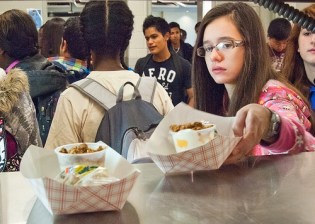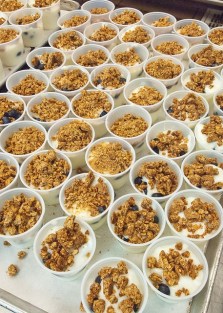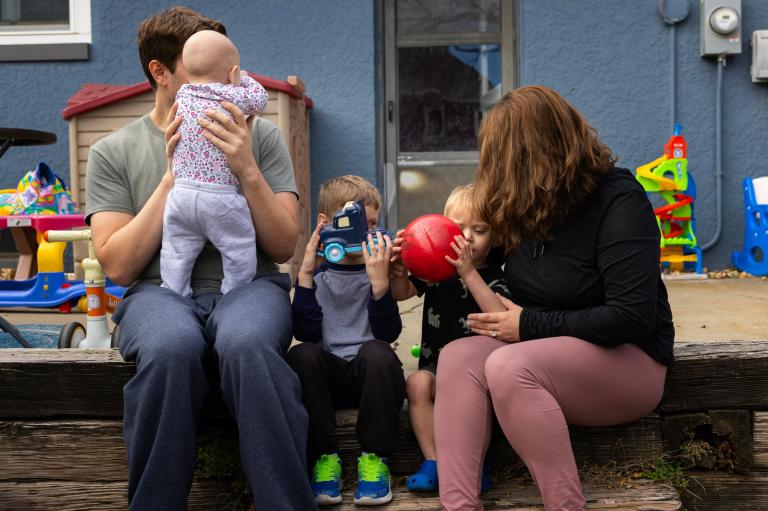
Seattle Schools hopes its new menu offerings will make students less skeptical of school lunch. (Photo by USDA.)
School lunch in Seattle has come a long way since I was a public school student. In the ’90s, lunch was only a dollar, and the cafeteria served up square, rubbery pizza, scoops of mushy spaghetti, and Belgian waffles (everyone’s favorite!). Fast-forward more than a decade: Elementary school lunch now costs $2.75, and for several years the Seattle School District has inched toward healthier offerings.
For most of public-school history, cafeteria food was something to be endured and then forgotten immediately upon graduating. But in recent years, many parents, health advocates, and doctors have targeted school lunch as one of the aspects of our food system most in need of scrutiny and reform. Since then, many of us have come to see bland, processed-food-heavy cafeteria cuisine less as a necessary evil and more as evidence of the way in which our government’s love affair with Big Ag takes a toll on public health. Not that revamping school lunch has proven easy: Public school districts struggle with extremely limited budgets, and the byzantine logistics of preparing and distributing food for thousands of children are especially tough to change.
So far, the most visible school-food makeovers have taken place in famously progressive towns like Boulder, Colo., and Berkeley, Calif. Most people won’t be surprised to learn that Seattle, with its rising foodie culture, is going the same route by enlisting the help of experienced restaurant chefs in overhauling its school lunches. But the Seattle School District’s size sets it apart from those liberal college towns, making its ambitions more challenging, and — if it succeeds — its tactics especially worth examining by other large school districts hoping to follow suit.
Wendy Weyer, Seattle Schools’ Child Nutrition Services director, says the district has a history of thinking outside the tray, especially when it comes to healthier ingredients like whole grains. “When I came here seven years ago,” she says, “we were serving brown rice when nobody else was.”
In the spring of 2010, the drive toward healthy school lunch in Seattle got an additional boost with a grant from the Centers for Disease Control. The goal was to form a partnership with local chefs to revamp the cafeteria menu. Soon, the district connected with Tom Douglas, a beloved Seattle chef whose company operates 12 highly regarded restaurants in the city.
“We were thrilled [about the partnership],” said Pamela Hinckley, CEO of Tom Douglas Restaurants (TDR). “We have so many employees with families in the public school system.”
“We want hot sauce!”
Hinckley and TDR chef Eric Tanaka worked closely with Weyer and Randall Guzzardo, operations manager for the Seattle School District’s central kitchen, learning the ins and outs of the district’s food-preparation and distribution system, as well as the federal pricing and nutrition guidelines. Then they set up student focus groups designed to discover what kids do and don’t like about school food, and also what they like to eat at home.
Although fish products often inspire wrinkled noses among schoolchildren, Weyer was surprised to hear a number of kids mention steamed white fish as a favorite home-cooked food. In response, the team developed a new recipe for a homemade provencal sauce over white baked fish. The district tested the dish out at a series of “family nights” held this fall, each at a different school in the district. “We had kids coming back for two or three servings [of fish],” Weyer said.
Misconceptions about what kids will and won’t eat can get in the way of creative menu changes. “A lot of people assume kids want bland food, but we found exactly the opposite,” Hinckley said. “On my notes from [the focus groups], in big scrawl, it says, ‘We want hot sauce!'”
The ideal vs. the reality
Once they’d identified meals that were both healthy and appealing to kids, the next step was finding ways to mass-produce them within the practical constraints of the public-school system.

The district plans to serve a yogurt parfait — one of its new menu offerings — this month. (Photo by USDA.)
“A lot of people want to approach [school-lunch reform] from the utopian outside and say, ‘Let’s just grow a garden and that will solve everything!'” Hinckley said. “But there’s so much more to working within the system.” For instance: Federal and state funds provide Seattle Schools with about $3 per student meal, but that amount must also cover labor costs. The district ends up with about $1.10 for the actual food — an amount Hinckley called “pathetic.”
Then there’s the fact that all food is prepared in a central commissary at district headquarters before being shipped out to 88 individual school kitchens (many of which resemble “a closet with a refrigerator and an oven,” Weyer said). The Berkeley school district implemented reforms through one central kitchen, but that district serves less than 10,000 students; over 47,000 kids attend public schools in Seattle, which means Weyer and Guzzardo’s team is responsible for producing 20,000 lunches a day — no simple task. “When you expand a recipe, the flavor changes,” Guzzardo says.
The central commissary works as a compromise between the higher labor cost of having a full-functioning kitchen at every school, and serving only frozen and reheated meals shipped from afar. But it does present a barrier to serving truly fresh food daily in every school.
“The food that’s created has to withstand being made two days early,” Hinckley says. “Food deteriorates in flavor, freshness, and aroma. That’s why school [food] smells funky! You don’t get onions sizzling, you get the smell of bags opening.”
Jazzing up the basics
Some ideas for new dishes — like a Thai spring roll — had to be altered to fit the infrastructure at hand. “So we’ll look at a different way we can do it — maybe a cold noodle dish,” says Guzzardo.
Weyer said that while the central kitchen makes baked goods and salad from scratch, most of the protein on the menu comes precooked. So the team jazzes it up with homemade ingredients like green tomatillo sauce on a prepared enchilada. To make pasta, Guzzardo uses fresh onions, garlic, basil, and parsley with commodity ground beef, and he’ll substitute half the canned pasta sauce for fresh diced tomatoes. “We’ve cut down the sodium by about 50 percent from what it was six years ago,” he said. “We’re constantly trying to innovate within the framework of what we can do.”
The district plans to move into 2012 serving a new taste-tested dish — like the enchiladas, the noodles, or a chicken and butternut squash curry with Israeli couscous — about once a week, as the production schedule allows. Although the grant money will run out in March, Weyer said the district hopes to work with TDR to phase more new recipes into the menu. And while TDR employees have donated their time, Hinckley is enthusiastic about keeping the collaboration going; her dream is to issue a call to all restaurants in Seattle in hopes of pairing one chef with every school in the district.
“None of this is going to happen overnight,” said Guzzardo. “But more of [these changes have] been going on over the last few years than people know. Our desire is for kids to get a better meal. No underlying glory is being sought, because there’s not a lot of glory in this.”
Weyer said she also hopes menu changes will help eliminate some stigmas attached to the school meal program. “In some schools, if you didn’t bring lunch from home that [means] you must be poor,” she said. But upgraded offerings could convince more “kids who haven’t been a part of our program to try a school lunch.”




